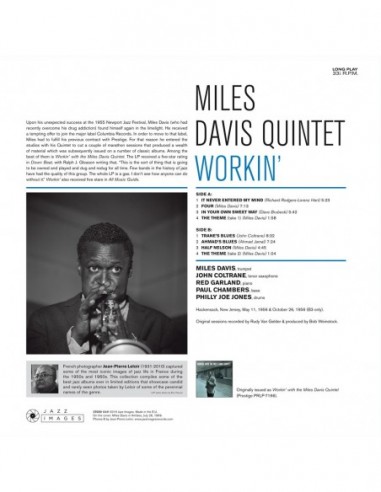Workin´
Miles DavisTHE JEAN-PIERRE LELOIR COLLECTION
180 pure virgin vinyl LPs in Gatefold packaging
Upon his unexpected success at the 1955 Newport Jazz Festival, Miles Davis (who had recently overcome his drug addiction) found himself again in the limelight. He received a tempting offer to join the major label Columbia Records. In order to move to that label, Miles had to fulfill his previous contract with Prestige. For that reason, he entered the studios with his Quintet to cut a couple of marathon sessions that produced a wealth of material which was subsequently issued on a number of classic albums.
Among the best of them is "Workin’" with the Miles Davis Quintet. The LP received a five-star rating in Down Beat, with Ralph J. Gleason writing that, “This is the sort of thing that is going to be owned and played and dug and redug for all time. Few bands in the history of jazz have had the quality of this group. The whole LP is a gas. I don’t see how anyone can do without it.” Workin’ also received five stars in All Music Guide.
PERSONNEL:
MILES DAVIS, trumpet
JOHN COLTRANE, tenor saxophone
RED GARLAND, piano
PAUL CHAMBERS, bass
PHILLY JOE JONES, drums
Hackensack, New Jersey, May 11, 1956 & October 26, 1956 (B3 only).
TRACKS:
SIDE A:
01 IT NEVER ENTERED MY MIND
02 FOUR
03 IN YOUR OWN SWEET WAY
04 THE THEME (take 1)
SIDE B:
01 TRANE’S BLUES
02 AHMAD’S BLUES
03 HALF NELSON
04 THE THEME (take 2)
- Format
- LP
- Discs
- 1
- Label code
- 37030
 Cookie preferences
Cookie preferences






















































